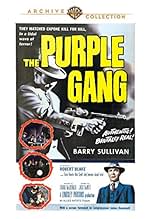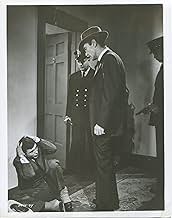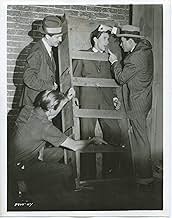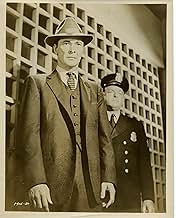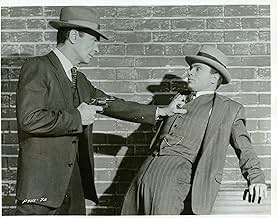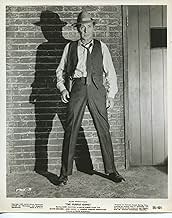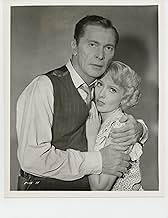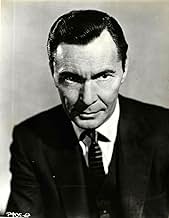Ajouter une intrigue dans votre langueThe story of the infamous Purple Gang, a ring of bootleggers, hijackers and killers in 1920s' Detroit.The story of the infamous Purple Gang, a ring of bootleggers, hijackers and killers in 1920s' Detroit.The story of the infamous Purple Gang, a ring of bootleggers, hijackers and killers in 1920s' Detroit.
- Réalisation
- Scénario
- Casting principal
Suzanne Ridgway
- Daisy
- (as Suzy Marquette)
Joe Turkel
- Eddie Olsen
- (as Joseph Turkel)
James Roosevelt
- Self in Prologue
- (as Congressman James Roosevelt)
Benjie Bancroft
- Police Officer
- (non crédité)
Avis à la une
Low budget "exposee" style film paints a somewhat accurate picture of Detroit's Purple Gang from the 20s. Worth seeing for Robert Blake's performance, which transcends the movie.
Most of my 7/10 goes to two things - Robert Blake's effective portrayal of completely amoral, calculating, and mentally unbalanced baby-faced mobster Honeyboy Willard and to the rather detached documentary feel of this film as it is narrated by the cop that has vowed to put the Purple Gang away, Barry Sullivan as Lt. William P. Harley of the Detroit Police. It really has the look and feel of "The Untouchables" except with poverty row roots.
There really was a Purple Gang in Detroit in the 20's and 30's, although the character of Honeyboy is a fictional one - the actual power in the real gang was in the hands of four Jewish brothers. The cleaner and dyers war was a real one, except in real life the Purple Gang was allied with the union against non-union independents. There was no rather clean ending to the story of the Purples in real life. Like so many other gangs, Prohibition gave them money and power they could have only dreamed about, and its end sent them on a slow decline with the primary source of their wealth literally dried up.
This film is unusual in that there are no female leads or even substantial female supporting roles here. Women are just the subjects of particularly savage crimes by the Purples, and very little more, meant to underscore the violence of the Purple Gang.
If this film had been in wider release by a bigger studio, maybe Robert Blake wouldn't have had to wait until 1967 and "In Cold Blood" to catapult to stardom. Here he steals the show, kills everyone else, and gives a truly riveting performance of a guy who really loves his work for reasons that seem to have more to do with a need for power and a desire to be feared than just pure greed. Don't believe the low rating on this one - give it a try realizing it is a B feature from a small studio made just as the production code was losing its grip.
There really was a Purple Gang in Detroit in the 20's and 30's, although the character of Honeyboy is a fictional one - the actual power in the real gang was in the hands of four Jewish brothers. The cleaner and dyers war was a real one, except in real life the Purple Gang was allied with the union against non-union independents. There was no rather clean ending to the story of the Purples in real life. Like so many other gangs, Prohibition gave them money and power they could have only dreamed about, and its end sent them on a slow decline with the primary source of their wealth literally dried up.
This film is unusual in that there are no female leads or even substantial female supporting roles here. Women are just the subjects of particularly savage crimes by the Purples, and very little more, meant to underscore the violence of the Purple Gang.
If this film had been in wider release by a bigger studio, maybe Robert Blake wouldn't have had to wait until 1967 and "In Cold Blood" to catapult to stardom. Here he steals the show, kills everyone else, and gives a truly riveting performance of a guy who really loves his work for reasons that seem to have more to do with a need for power and a desire to be feared than just pure greed. Don't believe the low rating on this one - give it a try realizing it is a B feature from a small studio made just as the production code was losing its grip.
This opens with a suit talking to the audience. The Purple Gang operated in Detroit during the late 20's and early 30's. They started out as bootleggers with Canadian liquor and quickly spread to all kinds of other crimes. The story begins with a teen gang called Purple led by William Joseph 'Honeyboy' Willard (Robert Blake). Police Lt. William P. Harley (Barry Sullivan) is assigned to clean it up. The kids take on the established mob and become their muscle. This launches them as the most violent criminals in the city.
I don't like the "Crime Does Not Pay" start. That takes this movie down to a B-short series. I also don't like them using a social worker as the foil. They could have used a lawyer, but they're trying to take down the bleeding heart liberal in a heavy handed way. The most interesting aspect of this is seeing Robert Blake. He's good, but that's about it.
I don't like the "Crime Does Not Pay" start. That takes this movie down to a B-short series. I also don't like them using a social worker as the foil. They could have used a lawyer, but they're trying to take down the bleeding heart liberal in a heavy handed way. The most interesting aspect of this is seeing Robert Blake. He's good, but that's about it.
Policeman Barry Sullivan fights Detroit's Purple Gang led by Robert Blake in the 1920s and 1930s in this Allied Artists programmer directed by Frank MacDonald. Quite obviously shot on studio lots and underdecorated sets, with a lot of stock footage edited into montages, it also features a high-speed narrative voice-over narrative by Sullivan.
The Purple Gang was a real Detroit mob, perhaps best remembered for being predominantly Jewish. The movie makes no indication of this.
Suzanne Ridgeway has a small part in this movie. She had entered the movies in 1937. Ultimately, she appeared in 233 feature films, 12 shorts and 13 television appearances. In that time, she was received on-screen credit four times, including the infamous FROM HELL IT CAME. This was her last movie appearance. She died in 1996, 78 years old, another of the forgotten horde of players whose presence helped make two Oscar winners and a multitude of other movies.
The Purple Gang was a real Detroit mob, perhaps best remembered for being predominantly Jewish. The movie makes no indication of this.
Suzanne Ridgeway has a small part in this movie. She had entered the movies in 1937. Ultimately, she appeared in 233 feature films, 12 shorts and 13 television appearances. In that time, she was received on-screen credit four times, including the infamous FROM HELL IT CAME. This was her last movie appearance. She died in 1996, 78 years old, another of the forgotten horde of players whose presence helped make two Oscar winners and a multitude of other movies.
The Purple Gang was a mob of bootleggers and hijackers with predominantly Jewish members operating in Detroit, Michigan, during the 1920s. They came to be Detroit's dominant criminal gang, but ultimately excessive violence and infighting caused the gang to self-destruct in the 1930s. This Allied Artists production, leveraged by a goodly amount of footage lifted from earlier films, plays fast and loose with what was an interesting history in a production weighted by two excellent leads, Sullivan and Blake, and which contains two or three memorably violent scenes while Blake's screaming claustrophobia offers other choice moments. Ultimately not one of the genre stand outs (for that one needs to seek out such titles as AL CAPONE or the RISE AND FALL OF LEGS DIAMOND etc) it is never the less a entertaining enough time waster even if it ends up feeling rather perfunctory. Sullivan's best gangster film, imho, is the appropriately named THE GANGSTER.
Le saviez-vous
- AnecdotesThe real Purple Gang was made up of mostly Jewish members. The script of this film gave the members non-Jewish names. It was the dominate criminal organization in Detroit from about 1927 until 1932 when the gang self-destructed - with help from the Italian mob.
- Citations
William Joseph 'Honeyboy' Willard: [instructing some henchmen before setting up a deal] No liquor, no junk and no broads when I'm runnin' the show.
- Crédits fous[Prologue] This picture is based on information from official files which revealed the shocking story of the wave of juvenile delinquency which spawned Detroit's Purple Gang. Incredible as it may seem, this youthful rat-pack of terrorists dominated the city's underworld for more than a decade during the prohibition era.
Meilleurs choix
Connectez-vous pour évaluer et suivre la liste de favoris afin de recevoir des recommandations personnalisées
Détails
- Durée
- 1h 25min(85 min)
- Couleur
- Rapport de forme
- 1.85 : 1
Contribuer à cette page
Suggérer une modification ou ajouter du contenu manquant

